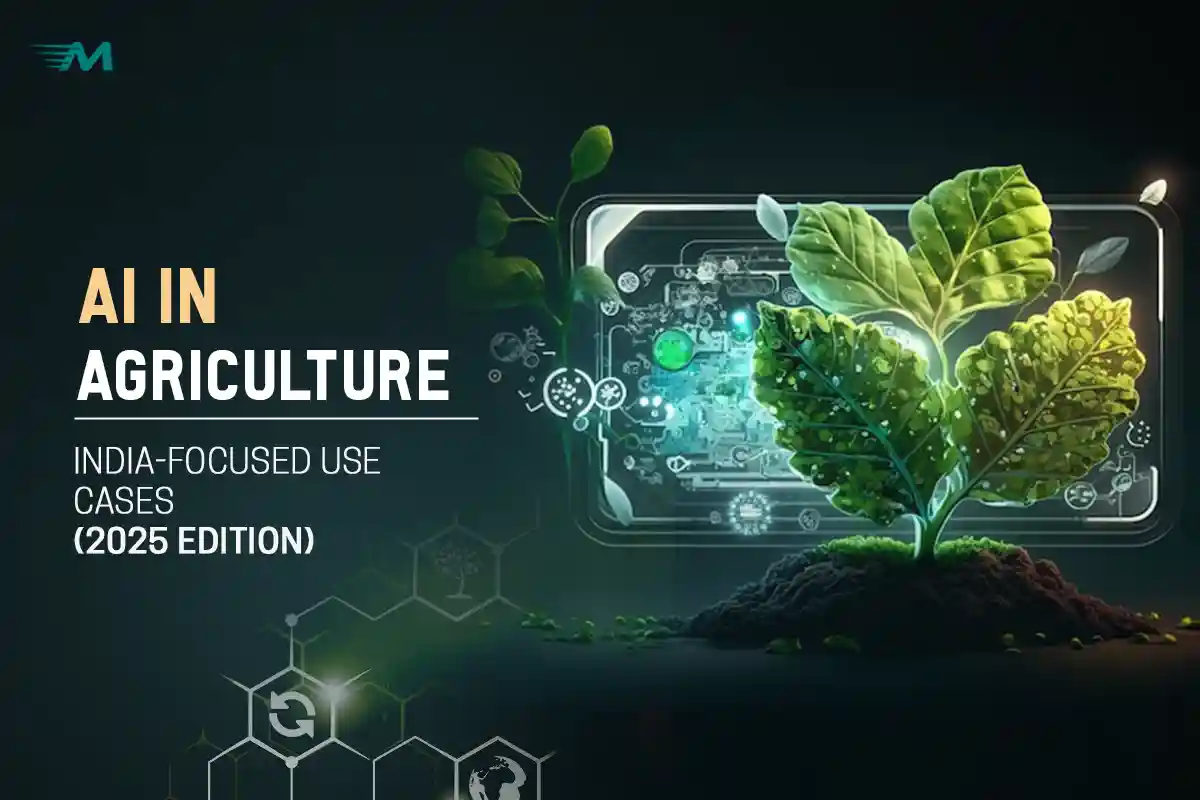AI in Agriculture: India-Focused Use Cases (2025 Edition)
India, with its rich agricultural heritage, has long relied on traditional farming methods. But in the face of climate change, increasing population, water scarcity, and the need for sustainable food production, the country is undergoing a technological revolution in agriculture. At the heart of this transformation is AI in Agriculture an innovation that’s making farming smarter, more efficient, and more predictive. In this blog, we explore how AI in Agriculture India is being implemented through real-world use cases that are reshaping how farmers work, plan, and produce.
Table of Contents
What is AI in Agriculture?
AI in agriculture refers to the use of advanced algorithms, machine learning, computer vision, and data analytics to enhance farming practices. These technologies help farmers make better decisions, automate repetitive tasks, and improve yield with minimal resource waste.
Why India Needs AI in Agriculture
India’s agricultural sector contributes around 18% to the country’s GDP and employs nearly 50% of the population. However, farmers still face challenges like:
- Unpredictable weather patterns
- Low productivity
- Crop diseases
- Water scarcity
- Market price volatility
AI can address many of these issues by enabling data-driven decisions and providing timely insights.
Top AI Use Cases in Indian Agriculture
1. Crop Disease Detection and Pest Control
AI-powered image recognition and drones help detect early signs of crop diseases and pest infestations. Startups like CropIn and Fasal use computer vision to identify plant health issues, sending real-time alerts to farmers via mobile apps.
Benefits:
- Prevents crop loss
- Reduces pesticide overuse
- Improves overall crop health
2. Smart Irrigation Systems
Water is a scarce resource in many Indian states. AI helps optimize irrigation by analyzing soil moisture, weather forecasts, and crop type to suggest when and how much to irrigate.
Example: Companies like AgSmartic use sensors and AI algorithms to automate irrigation.
Benefits:
- Saves water
- Increases productivity
- Reduces labor costs
3. Yield Prediction and Forecasting
AI algorithms analyze historical crop data, soil conditions, rainfall patterns, and satellite imagery to predict crop yields. This helps farmers plan better and supports government policies on food distribution.
Use Case: Microsoft India partnered with ICRISAT to use AI for predicting sowing dates and crop yields in Andhra Pradesh.
Benefits:
- Accurate harvest planning
- Reduced losses
- Better pricing strategies
4. Soil Health Monitoring
AI systems analyze soil samples to determine nutrient levels and recommend fertilizers accordingly. Mobile apps and devices make this accessible to even small-scale farmers.
Example: KrishiHub offers AI-based soil health reports with actionable advice.
Benefits:
- Informed fertilization
- Improved soil longevity
- Cost savings for farmers
5. AI-Powered Supply Chain Optimization
Once crops are harvested, AI helps streamline logistics, storage, and market delivery. Predictive analytics improve demand forecasting and minimize food waste.
Example: Platforms like DeHaat and Ninjacart use AI to connect farmers directly with buyers, reducing middlemen.
Benefits:
- Better market access
- Higher income for farmers
- Reduced spoilage
6. Weather Forecasting and Advisory
AI systems use real-time data to offer hyperlocal weather forecasts. These help farmers make informed decisions about sowing, harvesting, and pest control.
Example: The IBM Watson Decision Platform for Agriculture provides AI-based climate and agronomic insights to farmers.
Benefits:
- Reduced weather-related risks
- Improved farming schedules
7. Drone-based Crop Monitoring
Drones powered by AI can monitor large farmlands, detect anomalies, and map crop health visually. These tools are especially useful for precision farming in states like Punjab, Haryana, and Maharashtra.
Benefits:
- Quick, large-scale analysis
- Reduced human error
- Data-driven insights
Government and Startup Initiatives in India
Government Support
- Digital Agriculture Mission 2021–2025: Promotes AI, ML, IoT, and blockchain in farming.
- eNAM (National Agriculture Market): Uses AI to improve agri-market access.
- PM-KISAN & KCC schemes integrate digital data for targeted delivery.
Notable Startups
- CropIn: AI and data-driven farm management.
- Fasal: Smart farming with real-time alerts.
- AgNext: AI-based quality assessment of produce.
- BharatAgri: Personalized farming advisory using AI.
Challenges in Implementing AI in Indian Agriculture
Despite the potential, several hurdles remain:
- Digital illiteracy among small farmers
- High initial investment costs
- Limited internet connectivity in rural areas
- Lack of localized AI solutions in regional languages
Future of AI in Indian Agriculture
The future looks promising. As AI becomes more affordable and accessible, and as internet penetration increases, small and marginal farmers will start benefiting too. Collaborative efforts among startups, governments, and educational institutions will be crucial in driving adoption.
Emerging trends:
- AI + IoT (Internet of Things) for fully automated farms
- Blockchain-backed crop tracking
- AI-powered agri-credit risk evaluation
Final Thoughts
AI is not just a buzzword; it’s becoming the backbone of next-gen agriculture in India. From reducing costs to improving yields, AI has the power to revolutionize the way Indian farmers work. However, to unlock its full potential, we need inclusive access, proper training, and robust infrastructure.
As we move forward, AI in agriculture will play a crucial role in achieving food security, farmer welfare, and economic sustainability for Indian.
FAQs:
Q1. Can small farmers benefit from AI in India?
Yes, with affordable mobile-based AI tools and government support, small farmers can access actionable insights.
Q2. Are AI-based tools expensive?
While some solutions are costly, many startups and government programs offer low-cost or subsidized tools.
Q3. What crops are AI tools most useful for in India?
Wheat, rice, cotton, sugarcane, and horticultural crops are among the most supported crops in AI applications.
Q4. Is AI replacing farmers?
No. AI is designed to assist, not replace. It helps farmers make smarter decisions and reduce workload.
Q5. How can farmers access AI solutions?
Through mobile apps, agri-tech platforms, government programs, and Krishi Vigyan Kendras (KVKs).

